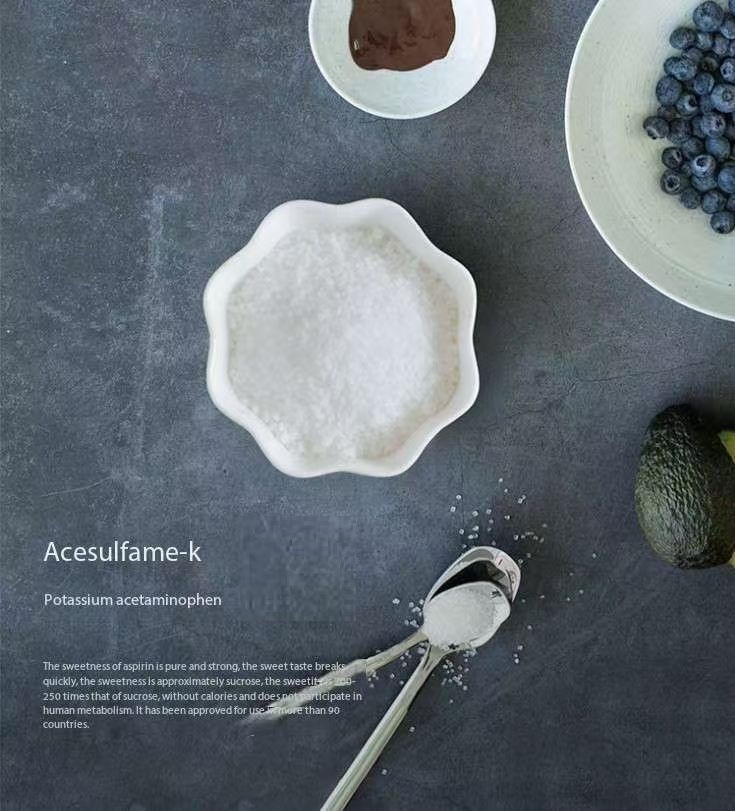| The characteristics and current situation of several synthetic sweeteners. |
| TIME:2025-02-19 HITS:513 |
|
Synthetic sweeteners are a class of compounds that are either artificially synthesized or semi-synthesized. Initially, the purpose of people exploring synthetic sweeteners was to increase their sweetness. Since the sweetness of sucrose is limited, excessive addition in many products not only leads to insufficient sweetness but also damages the texture of the products. Synthetic sweeteners have a high sweetness level and can meet the sweetness requirements with a small amount used. In fact, they also play a role in reducing costs. Therefore, since their introduction, synthetic sweeteners have been highly favored by the market.
With the advent of the era of healthy consumption, people no longer merely focus on surface factors such as taste and price when it comes to food, but pay more attention to the deep-seated health effects. Since synthetic sweeteners entered the market, their safety has been controversial. In fact, food safety departments in various countries have conducted scientific evaluations of their safety and unanimously agreed that their safety is guaranteed when used within a reasonable range. The continuous improvement of health awareness and the emergence of natural sweeteners have had a huge impact on synthetic sweeteners. However, this has not hindered the development of synthetic sweeteners. Instead, their overall production and sales volume have increased year by year, mainly due to the unparalleled superiority of synthetic sweeteners. In addition, synthetic sweeteners usually have very low calories, which is particularly suitable for the current pursuit of "low calories" and meets the demands of The Times. This article will introduce the usage of several common synthetic sweeteners.
Saccharin Saccharin is a artificial sweetener synthesized by humans. Its chemical name is phthalyl sulfonyl imide. The actual form used in the food industry is its sodium salt that is highly soluble in water. Therefore, it has a slight bitter and metallic taste, and its sweetness is 300 to 500 times that of sucrose. Sodium saccharin was once the main sweetener product in the world's food industry, with a market share of 55% during its most prosperous period in China. However, its safety is questionable. In 2017, the International Agency for Research on Cancer of the World Health Organization included saccharin and its salts in the list of Group 3 carcinogens. The usage of saccharin has been decreasing year by year. Currently, saccharin is more common in low-end products such as pickled vegetables. Sodium cyclamate Cyclamate is produced by the reaction of sulfamic acid with cyclohexylamine and sodium hydroxide. It was first discovered in 1937 and put into industrial production in 1950. It is known as the second-generation synthetic sweetener. The sweetness of cyclamate is 50 times that of sucrose, but its price is the lowest among all sweeteners. However, it is also a controversial synthetic sweetener. The issue of cyclamate causing cancer is the primary factor hindering its development. After the United States announced a ban on cyclamate use in 1968, many countries such as Japan and South Korea successively issued bans on cyclamate. In 1982, the Joint Expert Committee on Food Additives under the Food and Agriculture Organization of the United Nations and the World Health Organization evaluated the safety of cyclamate. It is confirmed that the use at a dose of 11mg/kg/day is safe, and the use of cyclamate in China is also legal. This is also the primary reason why many of China's export products are found to be substandard due to the detection of cyclamate. Aspartame Aspartame was originally a drug. Its sweet effect was discovered by chance in 1965. Its sweetness is about 200 times that of sucrose and it is a third-generation synthetic sweetener. Aspartame has a exposed amino group in its molecule, which is highly active. Therefore, aspartame is not heat-resistant and has poor stability in alkaline environments. It is suitable for low-temperature products such as beverages and is currently the most consumed sweetener. The currently confirmed risk factor is that phenylalanine is produced during its metabolic process, which can cause discomfort in patients with phenylketonuria. Acesulfame-K Acesulfame potassium was first discovered by the German company Hearst in 1967. It is a fourth-generation synthetic sweetener. Its sweetness is similar to that of aspartame, about 200 times that of sucrose, but its sweetness is slightly inferior and it has a more obvious metallic taste. Generally, acesulfame potassium is rarely seen used alone. It is usually used in combination with other sweeteners. On the one hand, it can mask its own metallic taste. On the other hand, it can exert a synergistic effect of enhancing sweetness. The safety of acesulfame potassium has been widely recognized. Coupled with its low price, it has become a powerful alternative to saccharin, cyclamate and other substances. Sucralose Sucralose is a new type of sweetener patented by Taylor's Company of the UK in 1976. It is one of the few sweeteners synthesized from sucrose and belongs to the fifth generation of synthetic sweeteners. Its sweetness is about 600 times that of sucrose. Most importantly, its sweetness is similar to that of sucrose, which can make the sweetness of the product purer. China started relatively late in this field, but its development has been quite ideal. The production scale is gradually expanding. Although it is under strict environmental protection pressure and its price is constantly rising, it is not lacking in international competitiveness. Sucralose is characterized by high safety, high sweetness, positive taste and good stability. Currently, the vast majority of countries around the world have approved sucralose as a sweetener. It is the fastest-growing synthetic sweetener globally, with a growth rate of approximately 15%. According to the data released by Xinsijie Industry Research Center, in 2018, the market share of sucralose and aspartame in China's artificial sweetener market was both 30%. If this trend continues, sucralose will soon surpass aspartame and firmly occupy the top position among synthetic sweeteners. Neotame Neotame is the latest generation of synthetic sweetener, with a sweetness approximately 6,000 times that of sucrose. Converted in terms of sweetness cost, its price is also very competitive. In addition, neotame has relatively high stability. After being baked at a high temperature of 450℃, 85% of neotame still exists. However, in actual production, its stability is not the main influencing factor, but uniformity. Due to its high sweetness, it has been applied in large-scale production, but the requirement for uniformity is also higher, and the phenomenon of uneven sweetness is very likely to occur. Currently, it is still in the market introduction stage and has a very low market share. The development of synthetic sweeteners will not stop. "survival of the fittest" is also the principle of its development. Besides meeting the requirements of the food industry, it must also meet consumers' demands for safety and health. Only in this way can synthetic sweeteners achieve substantial development.
Disclaimer: The news and information released on the ChemicalBook platform are provided only as knowledge and are intended for reference and exchange among industry insiders. No guarantee is made regarding their accuracy and completeness. You should not use this to replace your independent judgment. Therefore, any risks arising from the information should be borne by yourself and have nothing to do with ChemicalBook. The article covers all contents, including but not limited to text, pictures, etc. If there is any infringement, please contact us for handling!
|

 Focus on plant active ingredients
Focus on plant active ingredients  React to complaint within 24 hours once receive it
React to complaint within 24 hours once receive it  Free sample 10~50g
Free sample 10~50g  Serve multiple enterprises
Serve multiple enterprises 
 Tel:+86-135 2651 0795
Tel:+86-135 2651 0795 Add:Tongying Enterprise Headquarters, Intersection of Laodong Street and University South Road, Xinmi, Zhengzhou City, China.
Add:Tongying Enterprise Headquarters, Intersection of Laodong Street and University South Road, Xinmi, Zhengzhou City, China. Tel:+86-135 2651 0795
Tel:+86-135 2651 0795 Email:cassie@jy-additives.com
Email:cassie@jy-additives.com